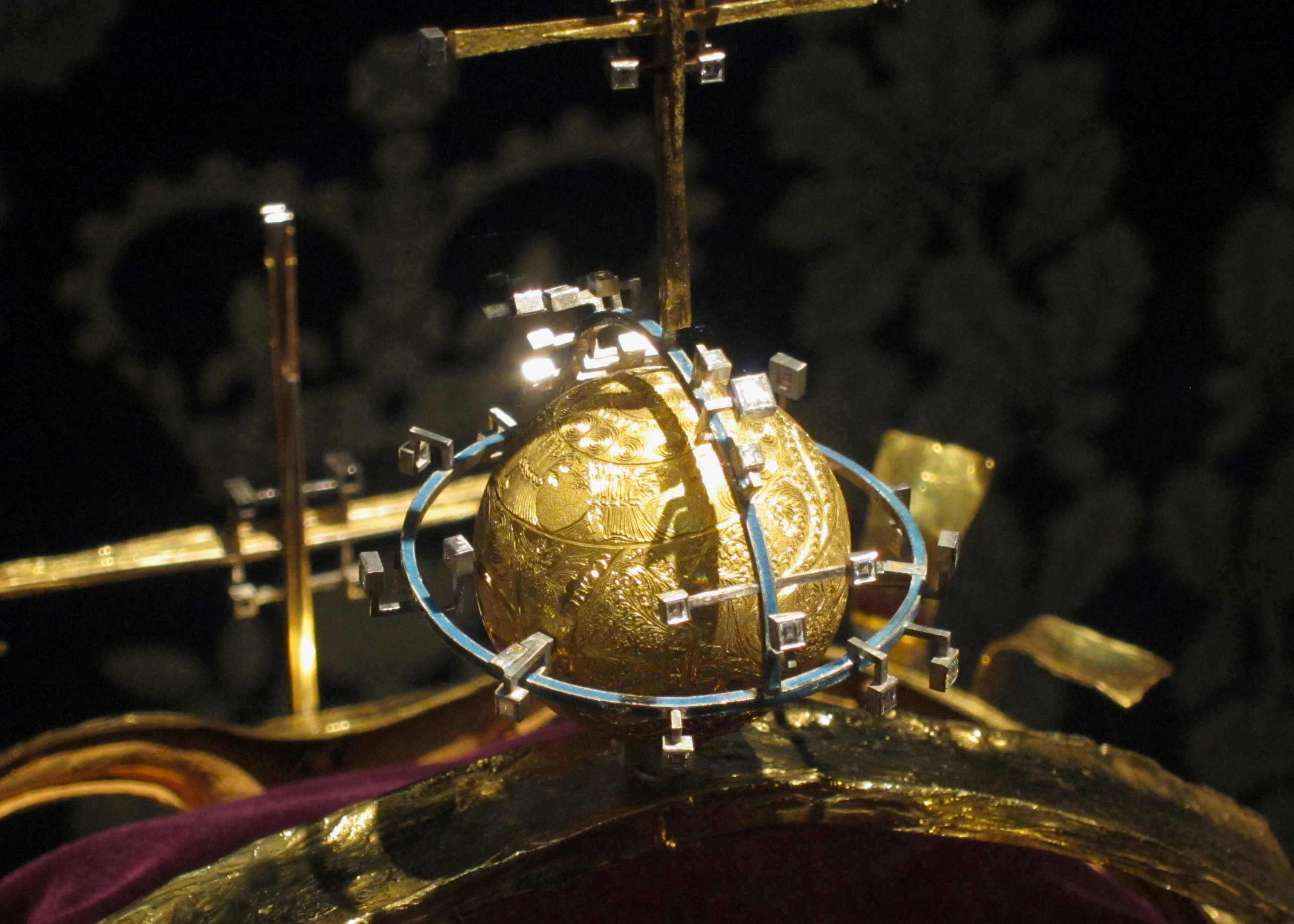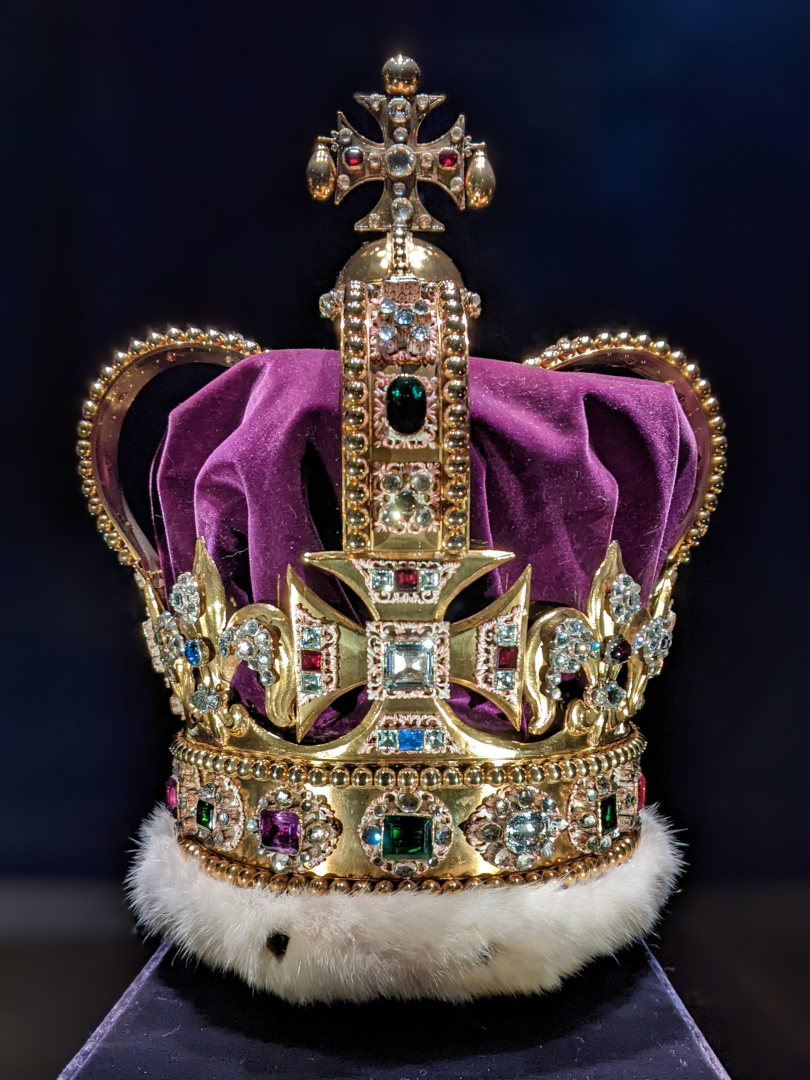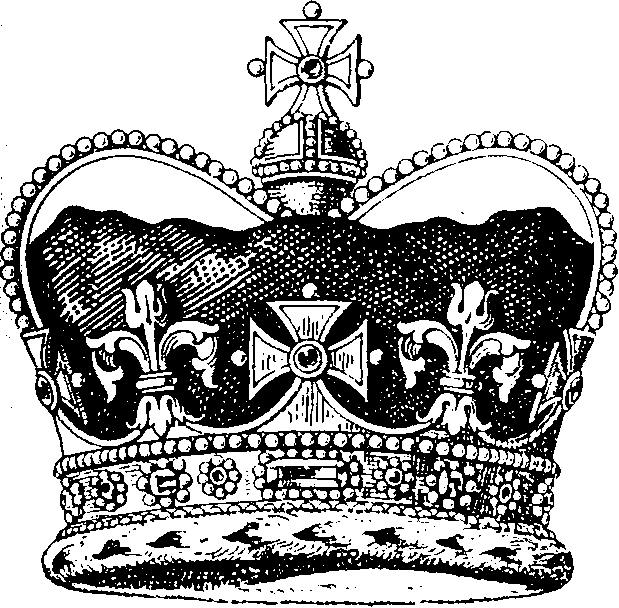|
Coronet Of Charles, Prince Of Wales
The Coronet of Charles, Prince of Wales is a small crown that is part of the Honours of Wales. The gold coronet, with diamonds set in platinum, was made for and used by King Charles III at his investiture as Prince of Wales in 1969. Designed by the artist Louis Osman, the coronet was a gift from the Worshipful Company of Goldsmiths to the Prince's mother, Queen Elizabeth II. It has been described as modern but its form is traditional. The coronet is on permanent display in the Jewel House at the Tower of London. Background When the former King Edward VIII went into exile as the Duke of Windsor in 1936 following his abdication, he took with him the Coronet of George, Prince of Wales – a highly controversial act. This coronet had been specially created for King George V, when Prince of Wales, and he wore it at his father's coronation in 1902. George's son, Edward, when Prince of Wales, wore it at the coronation of his father in 1911. In 1969, it was judged impractical ... [...More Info...] [...Related Items...] OR: [Wikipedia] [Google] [Baidu] |
Victoria & Albert Museum
The Victoria and Albert Museum (often abbreviated as the V&A) in London is the world's largest museum of applied arts, decorative arts and design, housing a permanent collection of over 2.27 million objects. It was founded in 1852 and named after Queen Victoria and Prince Albert. The V&A is located in the Royal Borough of Kensington and Chelsea, in an area known as " Albertopolis" because of its association with Prince Albert, the Albert Memorial and the major cultural institutions with which he was associated. These include the Natural History Museum, the Science Museum, the Royal Albert Hall and Imperial College London. The museum is a non-departmental public body sponsored by the Department for Digital, Culture, Media and Sport. As with other national British museums, entrance is free. The V&A covers and 145 galleries. Its collection spans 5,000 years of art, from ancient times to the present day, from the cultures of Europe, North America, Asia and North Af ... [...More Info...] [...Related Items...] OR: [Wikipedia] [Google] [Baidu] |
Coronet Of George, Prince Of Wales
The Crown Jewels of the United Kingdom, originally the Crown Jewels of England, are a collection of royal ceremonial objects kept in the Tower of London which include the coronation regalia and vestments worn by British monarchs. Symbols of over 800 years of monarchy, the coronation regalia are the only working set in Europe and the collection is the most historically complete of any regalia in the world. Objects used to invest and crown British monarchs variously denote their role as head of state of the United Kingdom and other countries of the Commonwealth, Supreme Governor of the Church of England, and head of the British armed forces. They feature heraldic devices and national emblems of England, Scotland, Wales and Northern Ireland. Use of regalia by monarchs in England can be traced back to when it was converted to Christianity in the Early Middle Ages. A permanent set of coronation regalia, once belonging to Edward the Confessor, was established after he was made a ... [...More Info...] [...Related Items...] OR: [Wikipedia] [Google] [Baidu] |
Star Sign
In Western astrology, astrological signs are the twelve 30-degree sectors that make up Earth's 360-degree orbit around the Sun. The signs enumerate from the first day of spring, known as the First Point of Aries, which is the vernal equinox. The astrological signs are Aries, Taurus, Gemini, Cancer, Leo, Virgo, Libra, Scorpio, Sagittarius, Capricorn, Aquarius, and Pisces. The Western zodiac originated in Babylonian astrology, and was later influenced by the Hellenistic culture. Each sign was named after a constellation the sun annually moved through while crossing the sky. This observation is emphasized in the simplified and popular sun sign astrology. Over the centuries, Western astrology's zodiacal divisions have shifted out of alignment with the constellations they were named after by axial precession of the Earth while Hindu astrology measurements correct for this shifting. Astrology (i.e. a system of omina based on celestial appearances) was developed in Chinese an ... [...More Info...] [...Related Items...] OR: [Wikipedia] [Google] [Baidu] |
Scorpius
Scorpius is a zodiac constellation located in the Southern celestial hemisphere, where it sits near the center of the Milky Way, between Libra to the west and Sagittarius to the east. Scorpius is an ancient constellation that pre-dates the Greeks; it is one of the 48 constellations identified by the Greek astronomer Ptolemy in the second century. Its old astronomical symbol is (♏︎). Notable features Stars Scorpius contains many bright stars, including Antares (α Sco), "rival of Mars," so named because of its distinct reddish hue; β1 Sco (Graffias or Acrab), a triple star; δ Sco ( Dschubba, "the forehead"); θ Sco ( Sargas, of unknown origin); ν Sco (Jabbah); ξ Sco; π Sco (Fang); σ Sco (Alniyat); and τ Sco (Paikauhale). Marking the tip of the scorpion's curved tail are λ Sco ( Shaula) and υ Sco (Lesath), whose names both mean "sting." Given their proximity to one another, λ Sco and υ Sco are sometimes referred to as the Cat's Eyes. The constellat ... [...More Info...] [...Related Items...] OR: [Wikipedia] [Google] [Baidu] |
Malcolm Appleby
Malcolm Appleby MBE (born 1946 in West Wickham) is a Scottish engraver. His public and private commissions include: the monde (orb) of the Coronet of Charles, Prince of Wales (1969); a 500th anniversary silver cup for the London Assay Office (1978); a raven gun for the Royal Armouries (1986); a cruet set for 10 Downing Street, commissioned by The Silver Trust (1988); a sculptural tablepiece for Bute House, Edinburgh, the residence of the First Minister for Scotland (1999); a silver teapot and gold beaded silver bowl for the Art Gallery of Western Australia in Perth, Australia (2000); and the Royal and Gannochy Trust Medals awarded by the Royal Society of Edinburgh (2000, 2003). Appleby trained at Beckenham School of Art, Ravensbourne College of Art, Central School of Arts and Crafts, Sir John Cass School of Art and the Royal College of Art. He was a Littledale Scholar at the Worshipful Company of Goldsmiths in 1969. He has lived in Scotland for most of his working life, an ... [...More Info...] [...Related Items...] OR: [Wikipedia] [Google] [Baidu] |
Coat Of Arms Of The Prince Of Wales
The coat of arms of the Prince of Wales is the official heraldic insignia of the Prince of Wales, a title traditionally granted to the heir apparent of the reigning monarch of the United Kingdom of Great Britain and Northern Ireland, formerly the Kingdom of Great Britain and before that the Kingdom of England. The coat of arms devised for Charles III, then Prince of Wales, in 1958, were the same as his granduncle, Edward VIII, had used as prince of Wales since 1911 (see below for references), and contained the badges and elements taken from all four of the constituent countries of the United Kingdom as well as from the many titles the prince holds as heir apparent. These arms lapsed when Charles became king. William, Prince of Wales currently uses the arms with the plain white label of an heir apparent without the additional badges and elements used by his father and previous generations to denote the title of prince of Wales. Since Edward I awarded it to his son the future E ... [...More Info...] [...Related Items...] OR: [Wikipedia] [Google] [Baidu] |
Futurism
Futurism ( it, Futurismo, link=no) was an artistic and social movement that originated in Italy, and to a lesser extent in other countries, in the early 20th century. It emphasized dynamism, speed, technology, youth, violence, and objects such as the car, the airplane, and the industrial city. Its key figures included the Italians Filippo Tommaso Marinetti, Umberto Boccioni, Carlo Carrà, Fortunato Depero, Gino Severini, Giacomo Balla, and Luigi Russolo. Italian Futurism glorified modernity and according to its doctrine, aimed to liberate Italy from the weight of its past. Important Futurist works included Marinetti's 1909 '' Manifesto of Futurism'', Boccioni's 1913 sculpture ''Unique Forms of Continuity in Space'', Balla's 1913–1914 painting ''Abstract Speed + Sound'', and Russolo's ''The Art of Noises'' (1913). Although Futurism was largely an Italian phenomenon, parallel movements emerged in Russia, where some Russian Futurists would later go on to found groups of ... [...More Info...] [...Related Items...] OR: [Wikipedia] [Google] [Baidu] |
Dukes In The United Kingdom
Duke, in the United Kingdom, is the highest-ranking hereditary title in all five peerages of the British Isles. A duke thus outranks all other holders of titles of nobility ( marquess, earl, viscount and baron or lord of parliament). The wife of a duke is known as a duchess, which is also the title of a woman who holds a dukedom in her own right, referred to as a duchess ''suo jure''; her husband, however, does not receive any title. In the order of precedence in the United Kingdom, non-royal dukes without state offices or positions generally take precedence before all other nobility, in order of date of creation, but after royalty and certain officers of state. Royal dukedoms A royal duke is a duke who is a member of the British royal family, entitled to the style of " His Royal Highness". The current royal dukedoms are, in order of precedence of their holders (that is, not in order of precedence of the dukedoms themselves): # Duke of Cornwall (England), Duke of Rothe ... [...More Info...] [...Related Items...] OR: [Wikipedia] [Google] [Baidu] |
Half-arch (crown)
A half-arch is the piece of gold, silver or platinum, usually decorated with jewels, that links the circlet (circular base) of a hoop crown to the monde at the top of the crown. Number of Arches British tradition of 4 half-arches The crowns of British monarchs traditionally contain four half-arches; examples include St. Edward's Crown, the State Crown of George I, the Coronation Crown of George IV and the Imperial State Crown. The same is true for several British consort crowns, namely the State Crown of Mary of Modena, the Crown of Queen Adelaide and the Crown of Queen Elizabeth The Queen Mother. Crown of the Prince of Wales's 1 arch The three crowns in existence of the Prince of Wales, the Heir Apparent to the British throne, all have one full arch, with a globe centred on the single arch rather than being the element to which each arch separately is joined, following an instruction laid down by King Charles II in 1677. Unlike the princely crowns of 1902 and 1969 how ... [...More Info...] [...Related Items...] OR: [Wikipedia] [Google] [Baidu] |
Charles II Of England
Charles II (29 May 1630 – 6 February 1685) was King of Scotland from 1649 until 1651, and King of England, Scotland and Ireland from the 1660 Restoration of the monarchy until his death in 1685. Charles II was the eldest surviving child of Charles I of England, Scotland and Ireland and Henrietta Maria of France. After Charles I's execution at Whitehall on 30 January 1649, at the climax of the English Civil War, the Parliament of Scotland proclaimed Charles II king on 5 February 1649. But England entered the period known as the English Interregnum or the English Commonwealth, and the country was a de facto republic led by Oliver Cromwell. Cromwell defeated Charles II at the Battle of Worcester on 3 September 1651, and Charles fled to mainland Europe. Cromwell became virtual dictator of England, Scotland and Ireland. Charles spent the next nine years in exile in France, the Dutch Republic and the Spanish Netherlands. The political crisis that followed Cromwell's death i ... [...More Info...] [...Related Items...] OR: [Wikipedia] [Google] [Baidu] |
Prince Of Wales Coronet Monde
A prince is a male ruler (ranked below a king, grand prince, and grand duke) or a male member of a monarch's or former monarch's family. ''Prince'' is also a title of nobility (often highest), often hereditary, in some European states. The female equivalent is a princess. The English word derives, via the French word ''prince'', from the Latin noun , from (first) and (head), meaning "the first, foremost, the chief, most distinguished, noble ruler, prince". Historical background The Latin word (older Latin *prīsmo-kaps, literally "the one who takes the first lace/position), became the usual title of the informal leader of the Roman senate some centuries before the transition to empire, the '' princeps senatus''. Emperor Augustus established the formal position of monarch on the basis of principate, not dominion. He also tasked his grandsons as summer rulers of the city when most of the government were on holiday in the country or attending religious rituals, and, ... [...More Info...] [...Related Items...] OR: [Wikipedia] [Google] [Baidu] |
Crown Jewels Of The United Kingdom
The Crown Jewels of the United Kingdom, originally the Crown Jewels of England, are a collection of royal ceremonial objects kept in the Tower of London which include the coronation regalia and vestments worn by British monarchs. Symbols of over 800 years of monarchy, the coronation regalia are the only working set in Europe and the collection is the most historically complete of any regalia in the world. Objects used to invest and crown British monarchs variously denote their role as head of state of the United Kingdom and other countries of the Commonwealth, Supreme Governor of the Church of England, and head of the British armed forces. They feature heraldic devices and national emblems of England, Scotland, Wales and Northern Ireland. Use of regalia by monarchs in England can be traced back to when it was converted to Christianity in the Early Middle Ages. A permanent set of coronation regalia, once belonging to Edward the Confessor, was established after he was made a s ... [...More Info...] [...Related Items...] OR: [Wikipedia] [Google] [Baidu] |







